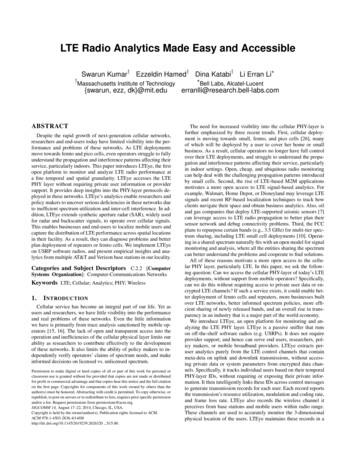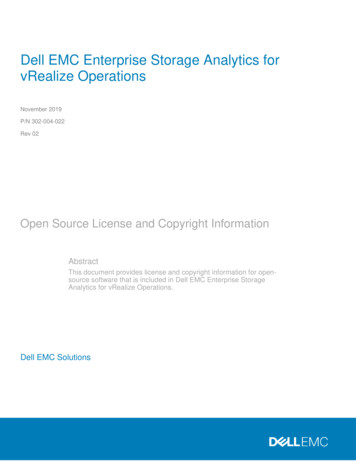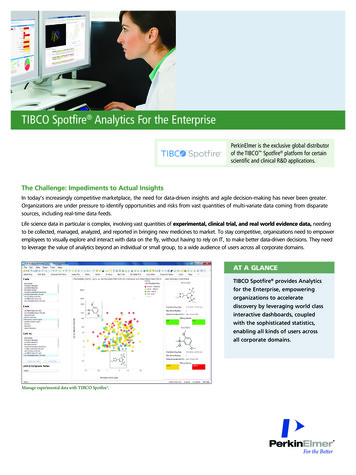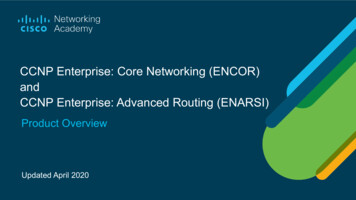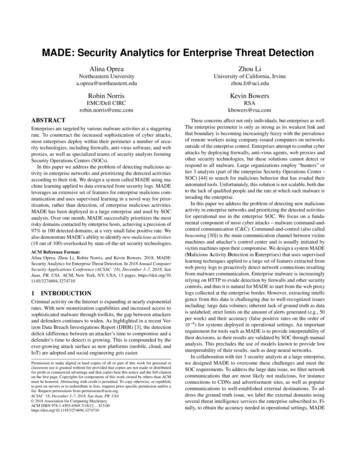
Transcription
MADE: Security Analytics for Enterprise Threat DetectionAlina OpreaZhou LiNortheastern Universitya.oprea@northeastern.eduUniversity of California, Irvinezhou.li@uci.eduRobin NorrisKevin BowersEMC/Dell Enterprises are targeted by various malware activities at a staggeringrate. To counteract the increased sophistication of cyber attacks,most enterprises deploy within their perimeter a number of security technologies, including firewalls, anti-virus software, and webproxies, as well as specialized teams of security analysts formingSecurity Operations Centers (SOCs).In this paper we address the problem of detecting malicious activity in enterprise networks and prioritizing the detected activitiesaccording to their risk. We design a system called MADE using machine learning applied to data extracted from security logs. MADEleverages an extensive set of features for enterprise malicious communication and uses supervised learning in a novel way for prioritization, rather than detection, of enterprise malicious activities.MADE has been deployed in a large enterprise and used by SOCanalysts. Over one month, MADE successfully prioritizes the mostrisky domains contacted by enterprise hosts, achieving a precision of97% in 100 detected domains, at a very small false positive rate. Wealso demonstrate MADE’s ability to identify new malicious activities(18 out of 100) overlooked by state-of-the-art security technologies.ACM Reference Format:Alina Oprea, Zhou Li, Robin Norris, and Kevin Bowers. 2018. MADE:Security Analytics for Enterprise Threat Detection. In 2018 Annual ComputerSecurity Applications Conference (ACSAC ’18), December 3–7, 2018, SanJuan, PR, USA. ACM, New York, NY, USA, 13 pages. ONCriminal activity on the Internet is expanding at nearly exponentialrates. With new monetization capabilities and increased access tosophisticated malware through toolkits, the gap between attackersand defenders continues to widen. As highlighted in a recent Verizon Data Breach Investigations Report (DBIR) [3], the detectiondeficit (difference between an attacker’s time to compromise and adefender’s time to detect) is growing. This is compounded by theever-growing attack surface as new platforms (mobile, cloud, andIoT) are adopted and social engineering gets easier.Permission to make digital or hard copies of all or part of this work for personal orclassroom use is granted without fee provided that copies are not made or distributedfor profit or commercial advantage and that copies bear this notice and the full citationon the first page. Copyrights for components of this work owned by others than ACMmust be honored. Abstracting with credit is permitted. To copy otherwise, or republish,to post on servers or to redistribute to lists, requires prior specific permission and/or afee. Request permissions from permissions@acm.org.ACSAC ’18, December 3–7, 2018, San Juan, PR, USA 2018 Association for Computing Machinery.ACM ISBN 978-1-4503-6569-7/18/12. . . 15.00https://doi.org/10.1145/3274694.3274710These concerns affect not only individuals, but enterprises as well.The enterprise perimeter is only as strong as its weakest link andthat boundary is becoming increasingly fuzzy with the prevalenceof remote workers using company-issued computers on networksoutside of the enterprise control. Enterprises attempt to combat cyberattacks by deploying firewalls, anti-virus agents, web proxies andother security technologies, but these solutions cannot detect orrespond to all malware. Large organizations employ “hunters” ortier 3 analysts (part of the enterprise Security Operations Center –SOC) [44] to search for malicious behavior that has evaded theirautomated tools. Unfortunately, this solution is not scalable, both dueto the lack of qualified people and the rate at which such malware isinvading the enterprise.In this paper we address the problem of detecting new maliciousactivity in enterprise networks and prioritizing the detected activitiesfor operational use in the enterprise SOC. We focus on a fundamental component of most cyber attacks – malware command-andcontrol communication (C&C). Command-and-control (also calledbeaconing [30]) is the main communication channel between victimmachines and attacker’s control center and is usually initiated byvictim machines upon their compromise. We design a system MADE(Malicious Activity Detection in Enterprises) that uses supervisedlearning techniques applied to a large set of features extracted fromweb proxy logs to proactively detect network connections resultingfrom malware communication. Enterprise malware is increasinglyrelying on HTTP to evade detection by firewalls and other securitycontrols, and thus it is natural for MADE to start from the web proxylogs collected at the enterprise border. However, extracting intelligence from this data is challenging due to well-recognized issuesincluding: large data volumes; inherent lack of ground truth as datais unlabeled; strict limits on the amount of alerts generated (e.g., 50per week) and their accuracy (false positive rates on the order of10 4 ) for systems deployed in operational settings. An importantrequirement for tools such as MADE is to provide interpretability oftheir decisions, as their results are validated by SOC through manualanalysis. This precludes the use of models known to provide lowinterpretability of their results, such as deep neural networks.In collaboration with tier 3 security analysts at a large enterprise,we designed MADE to overcome these challenges and meet theSOC requirements. To address the large data issue, we filter networkcommunications that are most likely not malicious, for instanceconnections to CDNs and advertisement sites, as well as popularcommunications to well-established external destinations. To address the ground truth issue, we label the external domains usingseveral threat intelligence services the enterprise subscribed to. Finally, to obtain the accuracy needed in operational settings, MADE
ACSAC ’18, December 3–7, 2018, San Juan, PR, USAleverages interpretable classification models in a novel way, by training only on malicious and unknown domains, and predicting theprobability that an unknown domain is malicious. Domains withhighest predicted probabilities can then be prioritized in the testingstage for investigation by the SOC. In designing MADE, we definedan extensive set of features to capture various behaviors of maliciousHTTP enterprise communication. In addition to generic, well-knownmalware features, MADE proposes a set of enterprise-specific features with the property of adapting to the traffic patterns of eachindividual organization. MADE performs careful feature and modelselection to determine the best-performing model in this context.MADE has been used in operational setting in a large enterprisewith successful results. In our evaluation, we demonstrate that overone month MADE achieves 97% precision in the set of 100 detecteddomains of highest risk, at the false positive rate of 6 · 10 5 (3 in50,000 domains in testing set). MADE detects well-known maliciousdomains (similar to those used in training), but also has the abilityto identify entirely new malicious activities that were unknown tostate-of-the-art security technologies (18 domains in the top 100 arenew detections by MADE).2 BACKGROUND AND OVERVIEW2.1 Enterprise Perimeter DefensesEnterprises deploy network-level defenses (e.g., firewalls, web proxies, VPNs) and endpoint technologies to protect their perimeteragainst a wide range of cyber threats. These security controls generate large amounts of security logs that are typically stored in acentralized security information and event management (SIEM) system. Large enterprises recognize that these protections are necessary,but not sufficient to protect themselves against continuously evolving cyber attacks. To augment their cyber defense capabilities, theyemploy incident response teams including security analysts tasked toanalyze alerts and detect additional suspicious activities. Most of thetime, security analysts use the collected security logs for forensic investigation. Once an attack is detected by some external mechanism,they consult the logs to detect the root cause of the attack.We are fortunate to collaborate with the Security OperationsCenter (SOC) of a large, geographically-distributed enterprise andobtain access to their security logs. The tier 3 security analysts of theSOC utilize a variety of advanced tools (host scanning, sandboxesfor malware analysis, threat intelligence services), but they relyquite extensively on manual analysis and their domain expertise foridentifying new malicious activities in the enterprise. In the broadestsense, the goal of our research is to design intelligent algorithms andtools for the SOC analysts that automatically detect and prioritizemost suspicious enterprise activities.2.2Problem definition and adversarial modelMore concretely, our goal is to use machine learning (ML) to proactively identify and prioritize external network communications related to a fundamental component of most enterprise cyber attacks.Our focus is on malware command-and-control (C&C) communication over HTTP or HTTPs, also called beaconing [30]. As enterprisefirewalls and proxies typically block incoming network connections,establishing an outbound malware C&C channel is the main communication mechanism between victims and attackers. This allowsAlina Oprea, Zhou Li, Robin Norris, and Kevin Bowersmalware operators to remotely control the victim machines, but alsoto manually connect back into the enterprise network by using, forinstance Remote Access Tools [21]. C&C is used extensively infully automated campaigns (e.g., botnets or ransomware such asWannacry [34]), as well as in APT campaigns (e.g., [42]).C&C increasingly relies on HTTP/HTTPs channels to maintaincommunication stealthiness by hiding among large volumes of legitimate web traffic. Thus, it is natural for our purposes to leverage theweb proxy logs intercepting all HTTP and HTTPs communicationat the border of the enterprise network. This data source is veryrich, as each log event includes fields like the connection timestamp,IP addresses of the source and destination, source and destinationport, full URL visited, HTTP method, bytes sent and received, statuscode, user-agent string, web referer, and content type. We design asystem MADE (Malicious Activity Detection in Enterprises) thatuses supervised learning techniques applied to a large set of featuresextracted from web proxy logs to proactively detect external networkconnections resulting from malware communication.In terms of adversarial model, we assume that remote attackershave obtained at least one footprint (e,g, victim machine) into theenterprise network. Once it is compromised, the victim initiatesHTTP or HTTPS communication from the enterprise network to theremote attacker. The communication from the victim and responsefrom the attacker is logged by the web proxies and stored in theSIEM system. We assume that attackers did not get full control of theSIEM system and cannot manipulate the stored security logs. Thatwill result in a much more serious breach that is outside our scope. Ifenterprise proxies decrypt HTTPS traffic (a common practice), oursystem can also handle encrypted web connections.Designing and deploying in operation a system like MADE isextremely challenging from multiple perspectives. Security logs arelarge in volume and more importantly, there is an inherent lack ofground truth as data is unlabeled. Existing tools (such as VirusTotal [2] and Alexa [6]) can be used to partially label a small fractionof data, while the large majority of connections are to unknowndomains (they are not flagged as malicious, but cannot be consideredbenign either). Our goal is to prioritize among the unknown domainsthe most suspicious ones and provide meaningful context to SOCanalysts for investigation. Finally, MADE is intended for use in production by tier 3 SOC analysts. This imposes choice of interpretableML models, as well as strict limits on the amount of alerts generated(at most 50 per week). Achieving high accuracy and low false positive rates when most of the data has unknown labels is inherentlydifficult in machine learning applications to cyber security [57].2.3System OverviewThe MADE system architecture is in Figure 1 and consists of thefollowing components:Training (Section 3). For training MADE, historical web proxy logsover three months are collected from the enterprise SIEM. (1) Inthe Data Filtering and Labeling phase, connections that are unlikelyC&C traffic (e.g., CDN, adware, popular domains) are excludedfrom the dataset and the malicious domains in the collected dataare labeled using Threat Intelligence services such as VirusTotal.(2) In Feature Extraction, a large number of features (89) are extracted using the domain expertise of SOC, measurement on our
MADE: Security Analytics for Enterprise Threat DetectionThreatintelligenceACSAC ’18, December 3–7, 2018, San Juan, PR, USA7. RankingHigh-RiskCommunications8. al dataEnterprisenetwork4. ModelSelectionTrainingWHOISGeolocation1. DataFiltering /Labeling2. FeatureExtraction3. FeatureSelectionHistoricaldataLRDTRFSVMTesting6. ModelPrediction5. DataRepresentationReal-time dataFigure 1: System architecture.SystemMalware TypeFeaturesMethodDataset sizeAccuracyDetect new malwareExecScent [45]Known malwarecommunicationURL, UA, Header valuesClustering158 million events per dayNoOprea et al. [47]Periodic malwarecommunicationMalware deliveryKnown maliciousInter-arrival timeCommunication, UAWHOISInter-arrival timeURL, Communication, LexicalScaling and shifting feature transformationInter-arrival timeLexicalBelief propagationPrioritization (top 375)660GB per dayTwo months66 TP / 13 FP (Dataset 1)32 TP / 26 FP (Dataset 2)2 TP / 23 FP (Dataset 3)289 TP / 86 FPClassificationon sequences of flows15 million flows90% precision67% recallNoTime-series auto-correlationClassificationPrioritization (top 50)30 billion events48 TP / 2 FPNoClassificationPrioritization (top 100)300 million events per day15 billion events total97 TP / 3 FPYesBartos et al. [11]BAYWATCH [30]Periodic malwarecommunicationMADEOur approachGeneric malwarecommunicationCommunication, DomainURL, UA, Result codeReferer, Content typeWHOIS, GeolocationYesTable 1: Comparison with previous systems for enterprise malware detection using web proxy logs. Legend: TP (True Positives), FP(False Positives).dataset, public reports on malware operations, and previous researchon malware analysis in the academic literature. We complement features extracted from HTTP logs with additional attributes availablefrom external data sources, e.g., domain registration informationfrom WHOIS data and ASN information from MaxMind [1]. (3)In Feature Selection, we rank the set of features and select a subsetwith highest information gain. (4) Finally, Model Selection analyzesvarious metrics of interest for four classes of supervised learningmodels (Logistic Regression, Decision Trees, Random Forest, andSVM) and selects the best performing ML model for our system.Testing (Section 4). In testing, new real-time data collected duringanother month is used into the ML model learned in the trainingphase. In (5) Data Representation the selected features are extractedfrom the new testing data, while (6) Model Prediction outputs domain risk scores using the trained ML model. (7) Ranking High-RiskCommunications prioritizes the most suspicious connections according to the SOC budget (10 per business day or 50 per week).Evaluation (Section 4). In (8) Evaluation, Analysis, and Feedbackthe list of most suspicious domains is manually investigated by tier3 SOC analysts and feedback is provided on MADE’s detections.2.4Comparison with previous workAs malware communication has been one of the most extensivelystudied topic in cyber security for many years, the reader mightwonder what MADE contributes new to this area. We would like tomention upfront the new features of MADE and how it comparesto previous work. MADE is designed to detect enterprise malwarecommunication and is the result of close collaboration over severalyears with the enterprise SOC in all aspects of the project fromproblem definition, to algorithm design, evaluation, and integrationinto operational settings. A number of relatively recent papers arealso specifically designed to detect malicious communication inenterprise settings from web proxy log analysis. These are the closestsystems related to MADE and they are surveyed in Table 1.One of the first systems in this space is ExecScent [45], whichexecutes malware samples in a sandbox and constructs communication templates. ExecScent has the benefit of detecting new malwarevariants by similarity with existing samples, but it is not designedto detect new malware. Oprea et al. [47] apply belief propagationto detect malware periodic communication and malware delivery inmulti-stage campaigns. Bartos et al. [11] design a system for genericmalware detection that classifies legitimate and malicious web flowsusing a number of lexical, URL, and inter-arrival timing featurescomputed for a sequence of flows. They propose a new feature representation invariant to malware behavior changes, but unfortunatelythe method does not retain feature interpretability. BAYWATCH [30]uses supervised learning based on inter-arrival timing and lexicalfeatures to detect periodic C&C or beaconing communication. As
ACSAC ’18, December 3–7, 2018, San Juan, PR, USAwe can see from the table, MADE has several interesting characteristics: (1) MADE uses the most extensive set of features to date foridentifying HTTP malware communication, carefully crafted basedon the SOC domain expertise; (2) MADE can identify various malware classes since it does not rely on timing or lexical features; (3)MADE achieves best precision from all prioritization-based systems(at similar false positive rates); (4) MADE identifies new malwarenot available during training and unknown to the community at thetime of detection; (5) MADE achieves interpretability of ML resultsand can be used successfully by SOC domain experts.MADE can detect general malware communication in enterprisenetwork. As discussed, previous systems are crafted for specifictypes of malware communication protocols (either with periodic timing [30, 47], or those that are similar to malware available in training [11, 45]). Therefore, there is no existing system with which wecan meaningfully compare the results achieved by MADE. Our hopeis that the community will create benchmarks including datasets andalgorithms publicly available in this space. But at the moment weare limited in deploying existing systems in our environment andcomparing them explicitly with MADE.2.5Ethical considerationsThe enterprise SOC provided us access to four months of data fromtheir SIEM system. Employees consent to their web traffic beingmonitored while working within the enterprise perimeter. Our datasetdid not include any personally identifiable information (PII). Ouranalysis was done on enterprise servers and we only exported aggregated web traffic features (as described in Table 3).3MADE TRAININGWe obtained access to the enterprise SIEM for a four month period inFebruary-March and July-August 2015. The number of events in theraw logs is on average 300 million per day, resulting in about 24TBof data per month. We use one month of data (July) for training aswe believe it is sufficient to learn the characteristics of the legitimatetraffic and one month (August) for testing. To augment the set ofmalicious domains, we used the February and March data to extractadditional malicious connections, which we include in the training set. We extract a set of e
web proxy logs to proactively detect network connections resulting from malware communication. Enterprise malware is increasingly relying on HTTP to evade detection by firewalls and other security controls, and thus it is natural for MADE to start from the web proxy logs collect
